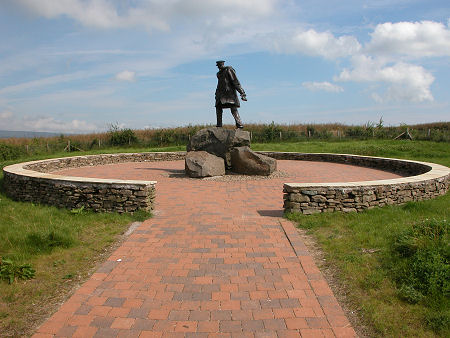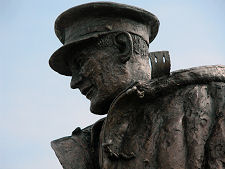 Memorial to David Stirling near Doune |
Colonel Sir David Stirling, OBE, DSO, lived from 15 November 1915 to 4 November 1990. He was a Scottish landowner, a keen mountaineer, World War II army officer, and founder of the Special Air Service. The wider picture in Scotland at the time is set out in our Historical Timeline.
Archibald David Stirling was born at the family home of Keir House three miles south-east of Doune. The estate now sits immediately to the west of the north end of the M9 motorway. His father was Brigadier General Archibald Stirling of Keir and his mother was Margaret Fraser, who in turn was a daughter of Lord Lovat. Stirling was educated at Ampleforth College in Yorkshire and Trinity College, Cambridge.
Stirling was in training for an attempt to climb Mount Everest when World War II broke out. He immediately enlisted in the Scots Guards as a sub-lieutenant. In June 1940 he volunteered for the newly-formed No.8 Commando under Lt. Col. Robert Laycock, which in early 1941 formed part of a group called Layforce trying to stem the advance of the German Afrika Corps in North Africa. Layforce was disbanded on 1 August 1941, leaving a frustrated Stirling convinced that there was an unrealised opportunity for a small, highly motivated and mobile force to cause considerable damage to the enemy.
Not one to see his ideas lost in an in-tray somewhere in the Army chain of command, Stirling decided to go straight to the top. Despite being on crutches following an accident during parachute training, he went to the Middle East headquarters in Cairo determined to see the Commander-in-Chief, General Claude Auchinleck. He ended up in the office of the British Deputy Commander in the Middle East, General Ritchie, who listened to Stirling's ideas, then conveyed them to Auchinleck.
The result was the formation by Stirling of a unit with the deliberately confusingly named, "L Detachment, Special Air Service Brigade" to help bolster a deception under way that the British had a parachute brigade based in North Africa. Their first mission involved parachuting behind enemy lines in support of a more general attack in November 1941. It was a complete failure, with only 22 out of 62 troopers reaching the rendezvous. Stirling decided on a change of tactics. In subsequent operations, SAS troopers were carried to an insertion point some distance from their target by the Long Range Desert Group, a motorised reconnaissance unit, and they then attacked under cover of night on foot before being picked up once more by the LRDG, which the SAS nicknamed the Libyan Desert Taxi Service. Using this approach, Stirling organised attacks on the German airfields at Aqedabia, Sirte and Agheila, in which the SAS destroyed 61 enemy aircraft without a single casualty.
When, in early 1942, German and Italian security around likely targets was increased to stop these raids, Stirling decided to acquire a number of heavily armed jeeps to carry out attacks much more swiftly, giving the SAS more chance to evade or overwhelm enemy patrols. By July 1942 the SAS regiment had 15 highly modified jeeps in action in North Africa. His commander at the time, Field Marshal Montgomery, was quoted as saying: "The boy Stirling is quite mad, quite, quite mad. However, in a war there is often a place for mad people."
David Stirling, by now promoted to lieutenant colonel, was captured by the Italians in January 1943. He escaped four times before being sent by the Germans to Colditz Castle, where he was to spend the rest of the war. In the 15 months up to his capture, the SAS had destroyed over 250 enemy aircraft on the ground, plus hundred of vehicles, and a huge quantity of stored supplies. After David Stirling's capture, command of his 1st SAS Regiment passed to Lieutenant Colonel Paddy Mayne, while David's brother, Lieutenant Colonel William Stirling, set up the 2nd SAS Regiment in Algeria. At the end of the war Stirling was promoted to Colonel and made Deputy Commander of the SAS Brigade, where his role included tracking down members of the SS and Gestapo responsible for shooting Special Forces prisoners.
Afterwards, Stirling initially settled in Rhodesia, where he promoted the idea of the Capricorn Society, a visionary scheme to unite Africa without regard to racial, political and religious divisions. He was also associated with instances of covert military action in the Middle East. Stirling came into the public view again in the UK in the aftermath of the 1974 miners' strike, when he set up a shadowy organisation called GB75, an organisation of apprehensive patriots who would help keep essential services running in the event of a general strike.
Sir David Stirling was knighted in 1990. He died the same year, and was buried at St Cumin's Church, on the shores of Loch Morar at Morar. Since 2002 the David Stirling Memorial has stood on the Hill of Row, near his ancestral home, looking towards the Perthshire mountains. It can be found just north of the B824 between the roundabout at the north end of the M9 and Doune.

